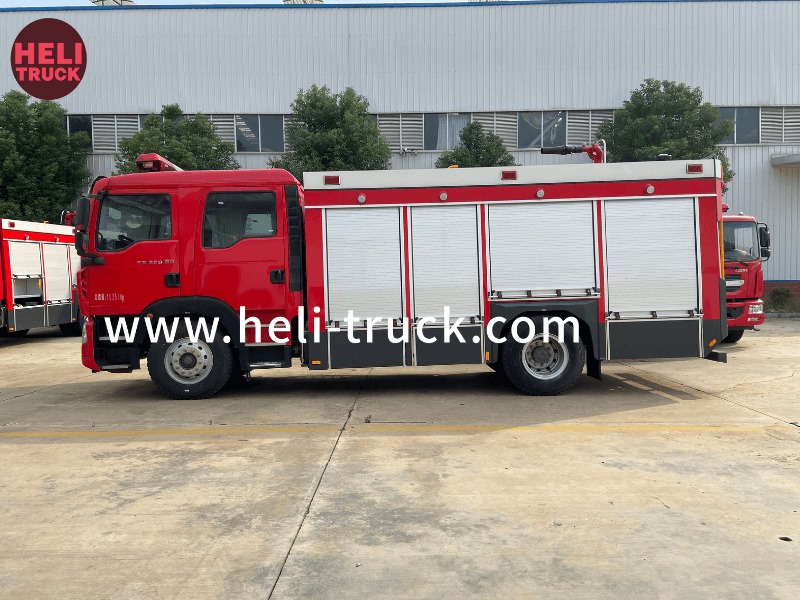Ensuring Effective Waste Disposal A Comprehensive Guide to Vacuum Truck Waste Disposal Inspection

Introduction
Waste disposal is a critical aspect of maintaining environmental cleanliness and public health. Vacuum trucks play a crucial role in the collection and disposal of various types of waste, ranging from liquid sludge to hazardous materials. To ensure that waste disposal is conducted efficiently and in compliance with regulations, regular inspections of vacuum trucks are essential. This article will provide a detailed overview of vacuum truck waste disposal inspection, highlighting the importance of thorough inspections, key components to check, and best practices to maintain the effectiveness and safety of waste disposal operations.
Importance of Vacuum Truck Waste Disposal Inspection
Vacuum trucks are versatile vehicles equipped with powerful suction mechanisms, making them ideal for collecting and transporting a wide range of waste materials. However, the nature of the waste being handled, as well as the conditions in which vacuum trucks operate, can lead to wear and tear on critical components. Regular inspection of vacuum trucks is crucial for several reasons:
1. Compliance with Regulations: Regulatory bodies such as the Environmental Protection Agency (EPA) and Occupational Safety and Health Administration (OSHA) have stringent guidelines for waste disposal operations. Water tank truck operations ensures that vacuum trucks meet these regulatory requirements, avoiding fines and penalties for non-compliance.
2. Preventative Maintenance: By conducting regular inspections, potential issues with vacuum trucks can be identified early and addressed before they escalate into costly repairs or breakdowns. Preventative maintenance is key to ensuring the longevity and efficiency of vacuum trucks.
3. Safety: Vacuum trucks often handle hazardous materials, posing risks to both the environment and personnel involved in waste disposal operations. Inspections help identify safety hazards and ensure that proper safeguards are in place to protect workers and the surrounding environment.
Key Components to Inspect
When conducting a waste disposal inspection of a vacuum truck, several key components should be thoroughly checked to ensure optimal performance and compliance with regulations. These components include:
1. Suction System: The suction system is the heart of a vacuum truck, responsible for collecting waste materials through a vacuum pump. Inspectors should check for any leaks, blockages, or malfunctions in the suction system that may affect its efficiency.
2. Tank and Valves: The tank of a vacuum truck holds the collected waste materials, while valves control the flow of materials in and out of the tank. Inspectors should ensure that the tank is in good condition, free of cracks or corrosion, and that valves are functioning properly to prevent spills or leaks during operation.
3. Filtration System: Vacuum trucks are equipped with filtration systems to separate solid materials from liquids during waste collection. Inspectors should check the condition of filters and screens, ensuring they are clean and free of damage to maintain the quality of collected waste.
4. Pumping System: The pumping system of a vacuum truck is responsible for transferring waste materials from the collection tank to the disposal site. Inspectors should check the pump for any signs of wear, leaks, or malfunctions that may hinder the pumping process.
5. Safety Equipment: Safety equipment such as emergency shutoff valves, spill containment mechanisms, and personal protective gear should be inspected to ensure they are in good working condition and readily available for use in case of emergencies.
Best Practices for Waste Disposal Inspection
To ensure that waste disposal inspections of vacuum trucks are conducted effectively and efficiently, several best practices should be followed:
1. Establish a Regular Inspection Schedule: Develop a routine inspection schedule for vacuum trucks based on factors such as frequency of use, type of waste materials handled, and environmental conditions. Regular inspections will help identify issues early and prevent unplanned downtime.
2. Train Inspection Personnel: Provide comprehensive training to personnel responsible for conducting waste disposal inspections. Training should cover equipment operation, safety protocols, and regulatory compliance to ensure that inspections are carried out accurately and efficiently.
3. Use Checklist and Documentation: Create a detailed inspection checklist that covers all essential components of a vacuum truck. Document inspection findings, including any deficiencies or maintenance requirements, to track the condition of each vehicle and facilitate follow-up actions.
4. Conduct Thorough Testing: In addition to visual inspections, conduct performance testing of critical components such as the suction system, pumping system, and safety equipment. Testing should be performed under realistic operating conditions to ensure that vacuum trucks are functioning as intended.
5. Address Issues Promptly: If any issues or deficiencies are identified during inspections, take immediate action to address them. Schedule repairs, maintenance, or replacement of components as needed to prevent disruptions to waste disposal operations.

Conclusion
Effective waste disposal is essential for maintaining environmental sustainability and public health. Vacuum trucks play a vital role in waste collection and transportation, making regular inspections of these vehicles critical to ensure compliance with regulations, prevent downtime, and maintain safety standards. By following best practices for waste disposal inspection, operators can identify and address issues early, ensuring the efficiency and effectiveness of waste disposal operations. Implementing a comprehensive inspection program for vacuum trucks is not only a regulatory requirement but also a proactive measure to protect the environment and promote sustainable waste management practices.
